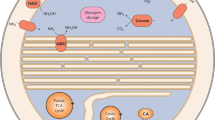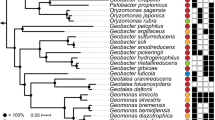Abstract
An anaerobic nitrate-reducing enrichment culture was established with a cyclic saturated petroleum hydrocarbon, cyclohexane, the fate of which in anoxic environments has been scarcely investigated. GC–MS showed cyclohexylsuccinate as a metabolite, in accordance with an anaerobic enzymatic activation of cyclohexane by carbon–carbon addition to fumarate. Furthermore, long-chain cyclohexyl-substituted cell fatty acids apparently derived from cyclohexane were detected. Nitrate reduction was not only associated with cyclohexane utilization but also with striking depletion of added ammonium ions. Significantly more ammonium was consumed than could be accounted for by assimilation. This indicated the occurrence of anaerobic ammonium oxidation (anammox) with nitrite from cyclohexane-dependent nitrate reduction. Indeed, nitrite depletion was stimulated upon further addition of ammonium. Analysis of 16S rRNA genes and subsequent cell hybridization with specific probes showed that approximately 75% of the bacterial cells affiliated with the Geobacteraceae and approximately 18% with Candidatus ‘Brocadia anammoxidans’ (member of the Planctomycetales), an anaerobic ammonium oxidizer. These results and additional quantitative growth experiments indicated that the member of the Geobacteraceae reduced nitrate with cyclohexane to nitrite and some ammonium; the latter two and ammonium added to the medium were scavenged by anammox bacteria to yield dinitrogen. A model was established to quantify the partition of each microorganism in the overall process. Such hydrocarbon oxidation by an alleged ‘denitrification’ (‘pseudo-denitrification’), which in reality is a dissimilatory loop through anammox, can in principle also occur in other microbial systems with nitrate-dependent hydrocarbon attenuation.
Similar content being viewed by others
Log in or create a free account to read this content
Gain free access to this article, as well as selected content from this journal and more on nature.com
or
Accession codes
References
Amann RI, Krumholz L, Stahl DA . (1990). Fluorescent-oligonucleotide probing of whole cells for determinative, phylogenetic, and environmental studies in microbiology. J Bacteriol 172: 762–770.
Anderson MS, Hall RA, Griffin M . (1980). Microbial metabolism of alicyclic hydrocarbons: cyclohexane catabolism by a pure strain of Pseudomonas sp. J Gen Microbiol 120: 89–94.
Boltz DF, Taras MJ . (1978). Nitrogen. In: Boltz DF, Howell JA (eds). Colorimetric Determination of Nonmetals. Wiley: New York, NY, USA. pp 197–251.
Champine JE, Underhill B, Johnston JM, Lilly WW, Goodwin S . (2000). Electron transfer in the dissimilatory iron-reducing bacterium Geobacter metallireducens. Anaerobe 6: 187–196.
Cheng Q, Thomas SM, Rouvière PE . (2002). Biological conversion of cyclic alkanes and cyclic alcohols into dicarboxylic acids: biochemical and molecular basis. Appl Microbiol Biotechnol 58: 704–711.
Dean JA . (1992). Lange's Handbook of Chemistry. McGraw-Hill: New York, NY, USA.
Eastcott L, Shiu WY, Mackay D . (1988). Environmentally relevant physical–chemical properties of hydrocarbons: a review of data and developments of simple correlations. Oil Chem Pollut 4: 191–216.
Ehrenreich P, Behrends A, Harder J, Widdel F . (2000). Anaerobic oxidation of alkanes by newly isolated denitrifying bacteria. Arch Microbiol 173: 58–64.
Jetten MSM, Niftrik LV, Strous M, Kartal B, Keltjens JT, Op den Camp HJM . (2009). Biochemistry and molecular biology of anammox bacteria. Crit Rev Biochem Mol Biol 44: 65–84.
Kartal B, Kuypers MMM, Lavik G, Schalk J, Op den Camp HJM, Jetten MSM et al. (2007). Anammox bacteria disguised as denitrifiers: nitrate reduction to dinitrogen gas via nitrite and ammonium. Environ Microbiol 9: 635–642.
Kropp KG, Davidova IA, Suflita JM . (2000). Anaerobic oxidation of n-dodecane by an addition reaction in a sulfate-reducing bacterial enrichment culture. Appl Environ Microbiol 66: 5393–5398.
Kuenen JG . (2008). Anammox bacteria: from discovery to application. Nat Rev Microbiol 6: 320–326.
Langenheim JH . (1994). Higher plant terpenoids: a phytocentric overview of their ecological roles. J Chem Ecol 20: 1223–1280.
Lovley DR, Baedecker MJ, Lonergan DJ, Cozzarelli IM, Phillips EJP, Siegel DI . (1989). Oxidation of aromatic contaminants coupled to microbial iron reduction. Nature 339: 297–300.
Lovley DR, Phillips EJP . (1988). Novel mode of microbial energy metabolism: organic carbon oxidation coupled to dissimilatory reduction of iron or manganese. Appl Environ Microbiol 54: 1472–1480.
Lowe KL, Dichristina TJ, Roychoudhury AN, Van Cappellen P . (2000). Microbiological and geochemical characterization of microbial Fe(III) reduction in salt marsh sediments. Geomicrobiol J 17: 163–178.
Ludwig W, Strunk O, Westram R, Richter L, Meier H, Yadhukumar et al. (2004). ARB: a software environment for sequence data. Nucleic Acids Res 32: 1363–1371.
Mulder A, van de Graaf AA, Robertson LA, Kuenen JG . (1995). Anaerobic ammonium oxidation discovered in a denitrifying fluidized bed reactor. FEMS Microbiol Ecol 16: 177–183.
Musat F . (2005). Physiological investigations of aerobic petroleum degradation in marine sediment microcosms. PhD thesis, University of Bremen, Germany.
Musat N, Werner U, Knittel K, Kolb S, Dodenhof T, Van Beusekom JEE et al. (2006). Microbial community structure of sandy intertidal sediments in the North Sea, Sylt-Rømø Basin, Wadden Sea. Syst Appl Microbiol 29: 333–348.
Pernthaler A, Pernthaler J, Amann R . (2002). Fluorescence in situ hybridization and catalyzed reporter deposition for the identification of marine bacteria. Appl Environ Microbiol 68: 3094–3101.
Perry JJ . (1984). Microbial metabolism of cyclic alkanes. In: Atlas RM (ed). Petroleum Microbiology. Macmillan: New York, NY, USA. pp 61–99.
Prince RC . (2002). Petroleum and other hydrocarbons, biodegradation of. In: Bitton G (ed). Encyclopedia of Environmental Microbiology. John Wiley: New York, NY, USA. pp 2402–2416.
Pruesse E, Quast C, Knittel K, Fuchs B, Ludwig W, Peplies J et al. (2007). SILVA: a comprehensive online resource for quality checked and aligned ribosomal RNA sequence data compatible with ARB. Nucleic Acids Res 35: 7188–7196.
Rabus R, Widdel F . (1995). Anaerobic degradation of ethylbenzene and other aromatic hydrocarbons by new denitrifying bacteria. Arch Microbiol 163: 96–103.
Rabus R, Widdel F . (1996). Utilization of alkylbenzenes during anaerobic growth of pure cultures of denitrifying bacteria on crude oil. Appl Environ Microbiol 62: 1238–1241.
Rabus R, Wilkes H, Behrends A, Armstroff A, Fischer T, Pierik AJ et al. (2001). Anaerobic initial reaction of n-alkanes in a denitrifying bacterium: evidence for (1-methylpentyl)succinate as initial product and for involvement of an organic radical in n-hexane metabolism. J Bacteriol 183: 1707–1715.
Rabus R, Wilkes H, Schramm A, Harms G, Behrends A, Amann R et al. (1999). Anaerobic utilization of alkylbenzenes and n-alkanes from crude oil in an enrichment culture of denitrifying bacteria affiliating with the β-subclass of the Proteobacteria. Environ Microbiol 1: 145–157.
Rios-Hernandez LA, Gieg LM, Suflita JM . (2003). Biodegradation of an alycyclic hydrocarbon by a sulfate-reducing enrichment from a gas condensate-contaminated aquifer. Appl Environ Microbiol 69: 434–443.
Rodrigues D, de Vasconcellos S, Alves P, Nascimento L, de Abreu B, de Oliveira V et al. (2005). Relationship between cyclohexyl-alkanoic acids and the acidothermophilic bacterium Alicyclobacillus spp.:evidence from Brazilian oils. Org Geochem 36: 1443–1453.
Rouvière PE, Chen MW . (2003). Isolation of Brachymonas petroleovorans CHX, a novel cyclohexane-degrading β-proteobacterium. FEMS Microbiol Lett 227: 101–106.
Schmid M, Schmitz-Esser S, Jetten M, Wagner M . (2001). 16S-23S rDNA intergenic spacer and 23S rDNA of anaerobic ammonium-oxidizing bacteria: implications for phylogeny and in situ detection. Environ Microbiol 3: 450–459.
Schmid M, Twachtmann U, Klein M, Strous M, Juretschko S, Jetten M et al. (2000). Molecular evidence for genus level diversity of bacteria capable of catalyzing anaerobic ammonium oxidation. Syst Appl Microbiol 23: 93–106.
Schmid MC, Maas B, Dapena A, van de Pas-Schoonen K, van de Vossenberg J, Kartal B et al. (2005). Biomarkers for in situ detection of anaerobic ammonium-oxidizing (Anammox) bacteria. Appl Environ Microbiol 71: 1677–1684.
Sikkema J, de Bont JAM, Poolman B . (1994). Interactions of cyclic hydrocarbons with biological membranes. J Biol Chem 269: 8022–8028.
Sikkema J, de Bont JAM, Poolman B . (1995). Mechanisms of membrane toxicity of hydrocarbons. Microbiol Rev 59: 201–222.
Simon J . (2002). Enzymology and bioenergetics of respiratory nitrite ammonification. FEMS Microbiol Rev 26: 285–309.
Snaidr J, Amann R, Huber I, Ludwig W, Schleifer K-H . (1997). Phylogenetic analysis and in situ identification of bacteria in activated sludge. Appl Environ Microbiol 63: 2884–2896.
Stamatakis A, Hoover P, Rougemont J . (2008). A rapid bootstrap algorithm for the RAxML web-servers. Syst Biol 75: 758–771.
Stirling LA, Watkinson RJ . (1977). Microbial metabolism of alicyclic hydrocarbons: isolation and properties of a cyclohexane-degrading bacterium. J Gen Microbiol 99: 119–125.
Tissot BP, Welte DH . (1984). Petroleum Formation and Occurence. Springer: Berlin, Germany.
Toh SK, Ashbolt NJ . (2002). Adaptation of anaerobic ammonium-oxidising consortium to synthetic coke-ovens wastewater. Appl Microbiol Biotechnol 59: 344–352.
Townsend GT, Prince RC, Suflita JM . (2004). Anaerobic biodegradation of alicyclic constituents of gasoline and natural gas condensate by bacteria from an anoxic aquifer. FEMS Microbiol Ecol 49: 129–135.
Trower MK, Buckland RM, Higgins R, Griffin M . (1985). Isolation and characterization of cyclohexane-metabolizing Xanthobacter sp. Appl Environ Microbiol 49: 1282–1289.
van Dijken JP, Harder W . (1975). Growth yields of microorganisms on methanol and methane. A theoretical study. Biotechnol Bioeng 17: 15–30.
Van Hamme JD, Singh A, Ward OP . (2003). Recent advances in petroleum microbiology. Microbiol Mol Biol Rev 67: 503–549.
Widdel F . (2009). Cultivation of anaerobic microorganisms with hydrocarbons as growth substrates. In: Timmis KN (ed). Handbook of Hydrocarbon and Lipid Microbiology. Springer: Heidelberg, Germany. pp 3787–3798.
Widdel F, Knittel K, Galushko A . (2009). Anaerobic hydrocarbon-degrading microorganisms: an overview. In: Timmis KN (ed). Handbook of Hydrocarbon and Lipid Microbiology. Springer: Heidelberg, Germany. pp 1997–2022.
Widdel F, Pfennig N . (1992). The genus Desulfuromonas and other Gram-negative sulfur-reducing eubacteria. In: Balows A, Trüper HG, Dworkin M, Harder W, Schleifer K-H (eds). The Prokaryotes. Springer: New York, NY, USA. pp 3379–3389.
Wilkes H, Boreham C, Harms G, Zengler K, Rabus R . (2000). Anaerobic degradation and carbon isotopic fractionation of alkylbenzenes in crude oil by sulphate-reducing bacteria. Org Geochem 31: 101–115.
Wilkes H, Kuhner S, Bolm C, Fischer T, Classen A, Widdel F et al. (2003). Formation of n-alkane- and cycloalkane-derived organic acids during anaerobic growth of a denitrifying bacterium with crude oil. Org Geochem 34: 1313–1323.
Wilkes H, Rabus R, Fischer T, Armstroff A, Behrends A, Widdel F . (2002). Anaerobic degradation of n-hexane in a denitrifying bacterium: further degradation on the initial intermediate (1-methylpentyl)succinate via C-skeleton rearrangement. Arch Microbiol 177: 235–243.
Wischgoll S, Heintz D, Peters F, Erxleben A, Sarnighausen E, Reski R et al. (2005). Gene clusters involved in anaerobic benzoate degradation of Geobacter metallireducens. Mol Microbiol 58: 1238–1252.
Acknowledgements
We thank Niculina Musat for help with whole-cell hybridization, Ramona Appel for technical assistance and an anonymous reviewer for stimulating comments. This work was supported by the Max-Planck-Gesellschaft and the European Community project MATBIOPOL (EVK3-CT1999-00010, 2000-2003; grant to FW).
Author information
Authors and Affiliations
Corresponding author
Rights and permissions
About this article
Cite this article
Musat, F., Wilkes, H., Behrends, A. et al. Microbial nitrate-dependent cyclohexane degradation coupled with anaerobic ammonium oxidation. ISME J 4, 1290–1301 (2010). https://doi.org/10.1038/ismej.2010.50
Received:
Revised:
Accepted:
Published:
Issue date:
DOI: https://doi.org/10.1038/ismej.2010.50
Keywords
This article is cited by
-
Fungal biotransformation of short-chain n-alkylcycloalkanes
Applied Microbiology and Biotechnology (2019)
-
Anaerobic Benzene Mineralization by Nitrate-Reducing and Sulfate-Reducing Microbial Consortia Enriched From the Same Site: Comparison of Community Composition and Degradation Characteristics
Microbial Ecology (2018)
-
Denitrification synergized with ANAMMOX for the anaerobic degradation of benzene: performance and microbial community structure
Applied Microbiology and Biotechnology (2017)
-
A Review on the Genetics of Aliphatic and Aromatic Hydrocarbon Degradation
Applied Biochemistry and Biotechnology (2016)



